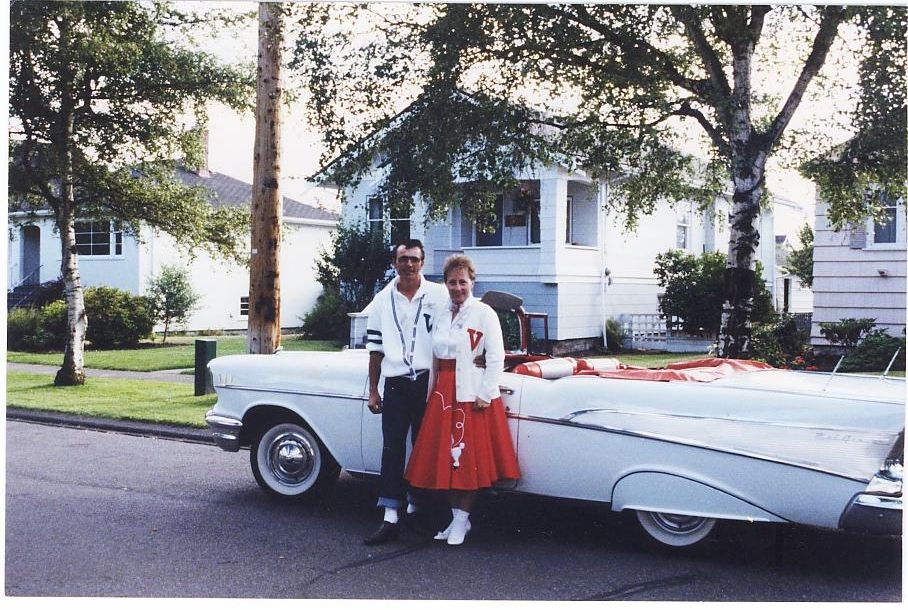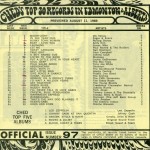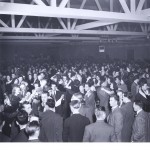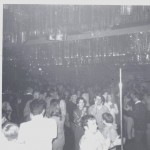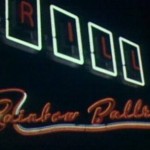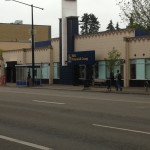Every Friday a thousand teenagers would line up under the red neon sign to hear local bands like The Lords (Privilege), Southbound Freeway, and The Nomads sing while they danced the night away.
Shirley Lowe, a longtime resident of Edmonton and its former Historian Laureate, was a regular at the Rainbow at the time, even though she was under 18 years old (the official minimum age). “We would pile as many girls as would fit in a car or we would take a cab out,” she recalls. “Then we would bring the same piece of ID and pass it down the line. We didn’t have picture IDs in those days, so as long as you could spell the name and knew the birth date on the card, you were okay. I don’t think they really cared, though.”
Once you got in the front door, you walked down a long hall before passing through a set of doors – with a concession next to it — into the main room. “We stepped down to the wooden dance floor, which was absolutely huge,” Lowe remembers. Girls would line the walls waiting to be asked to dance, or would cluster in the booths with friends to sit out a song or to talk with a boy. Most apparently ignored the painted murals – there’s one of an idyllic Rocky Mountain escape, complete with canoe and snow-capped peaks that famous photographer Lynne Cohen captured in black and white. It says 1975 on the National Gallery of Canada’s caption, but it feels like the mural could be a remnant of the 1940s and ‘50s when the Rainbow hosted ballroom dancing and the music of Tommy Banks and other big band musicians. Lowe certainly remembered the murals were past their prime and out of step with the vibe of the place by the late 1960s.
That vibe was more like the latest seasons of Mad Men, full of counter-culture bearded men with long hair. Even so, the story that Horst Urbaniak tells of the night he met his wife-to-be Joyce Tverdeay at the Rainbow, almost sounds like an episode of Happy Days. “I was out with two of my friends cruising the Highlands A&W drive-in – the A&W Lords used to play on the roof – kids would drive in, order and get out and dance in the aisles,” he recalls.
“I talked my buddies into going to the Rainbow Ballroom and there were two girls standing there by themselves,” Urbaniak says. “I love to dance, so we got them up.” Even though she preferred the more mod Beatles look to Urbaniak’s “Greaser” (“hair slicked back, cigarette pack tucked into my sleeve”), he and Tverdeay began dating. That meant Friday nights at the Rainbow Ballroom and Saturdays at Ma-Me-O Beach dances.
“We worked all week, saved our pennies for gas, burgers, dance admissions and a case of wobblypops,” Urbaniak recalls. The Rainbow was a dry bar, however – the drinking age in Alberta was 21 at the time – so patrons like Urbaniak would sit in their cars drinking those wobblypops (small brown bottles of beer) before heading inside. Shirley Lowe also remembers it was a common practice to “preload” either in cars or at the Strathcona Bar, where university students rubbed elbows with Canadian Pacific Railway employees. Still, some would sneak booze in and drink it in the back of the Rainbow. Then, once the hall closed for the night, people would head out to house parties, but it wasn’t always a smooth transition. “The girls would go googly over the band members,” Urbaniak says, “and the boyfriends would get mad and wait for the band guys outside to fight.”
Urbaniak was more a lover than a fighter, and after seven months of dating, he proposed to Tverdeay. “We were at the A&W on 109th Street at the rat hole – the tunnel underneath the train tracks – after a night of dancing,” he says. “After we got married in 1970, we drove out to Vancouver for a honeymoon.” The two ended up moving there shortly afterward and spent over 40 years raising their family together. They never returned to the Rainbow Ballroom, but Ubaniak has always fondly remembered those Friday nights. “I had the love of my life in my arms and we were oblivious to everything except ourselves and the great music we were dancing to.”
Lowe says the Rainbow Ballroom faded from view as the baby boomers grew up, Disco replaced Rock & Roll, and Whyte Avenue’s character changed for the worst. It eventually closed its doors as a dance hall, becoming the Rainbow Ballroom Bingos and Mother’s Music/TheDrum Shop in the 1980s and 1990s.
Now the site houses a Royal Bank of Canada branch, a somewhat staid reincarnation, perhaps. But the music and memories live on through reunion concerts and online communities, and there are even echoes of the old Rainbow Ballroom in RBC’s acronym. I can only hope that the bankers tap their toes to the faint echoes of “Devil in a Blue Dress” as they close up on Friday nights at what was once Edmonton’s music mecca.
© Danielle Metcalfe-Chenail 2014
Please note: Horst Urbaniak is still searching for an elusive exterior shot of the Rainbow Ballroom for a project he’s putting together to commemorate his wife’s memory. If you have one in your collection, please contact him at 567chevy[at]telus[dot]net
Top Photo
Horst + Joyce Victoria 1989. Courtesy of the Horst Urbaniak Collection.
Resources
Dwayne Allen Osepchuk runs Edmonton’s Rock & Roll History Page on Facebook and has a great YouTube channel featuring songs and clips from bands of this era.

